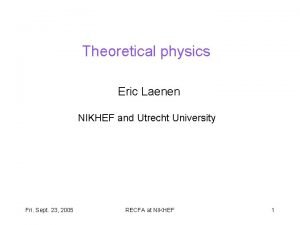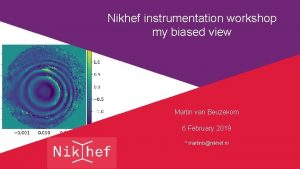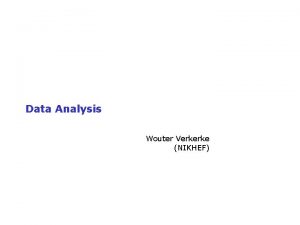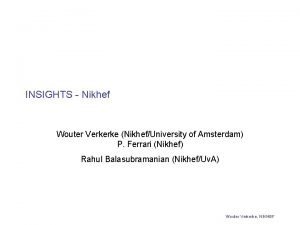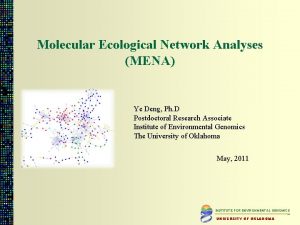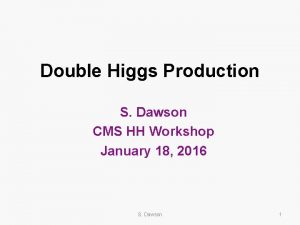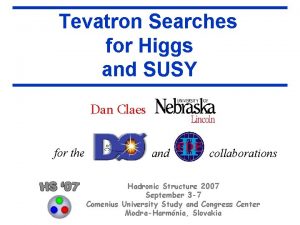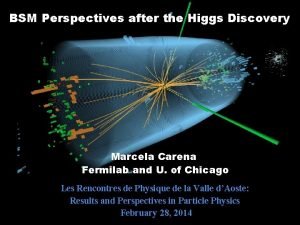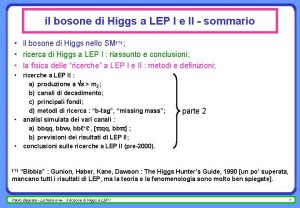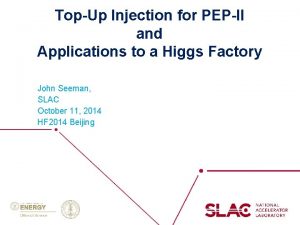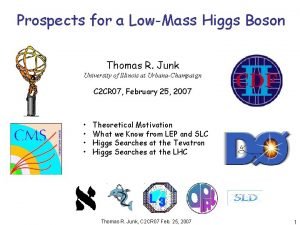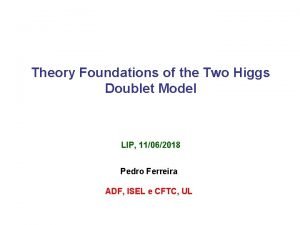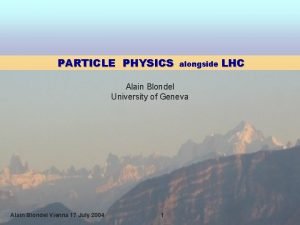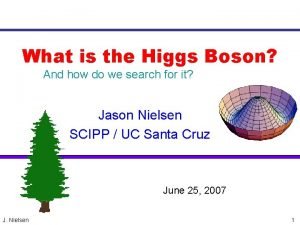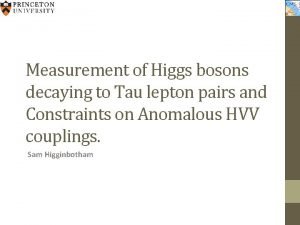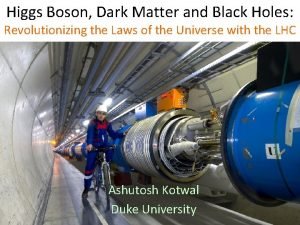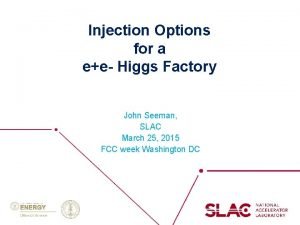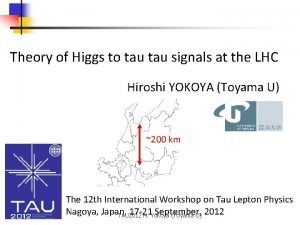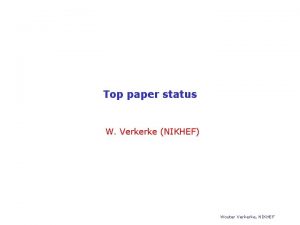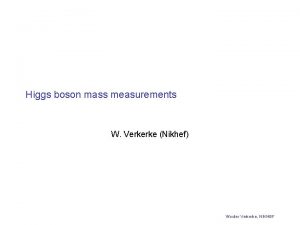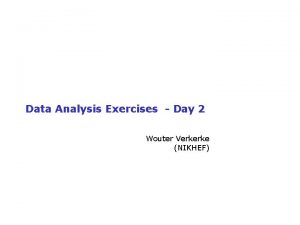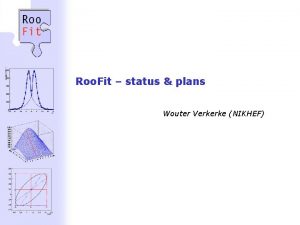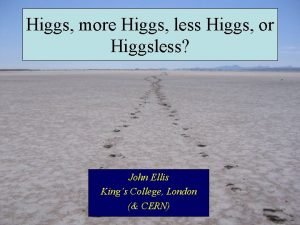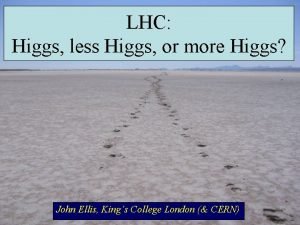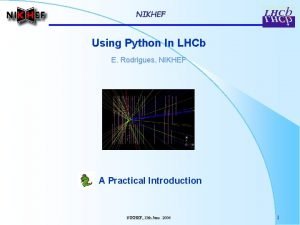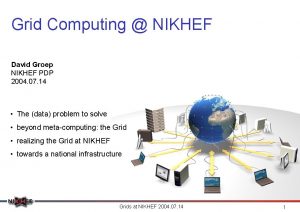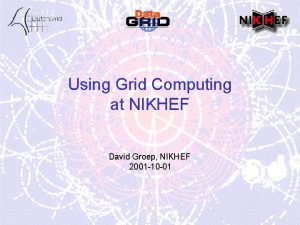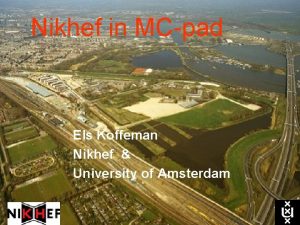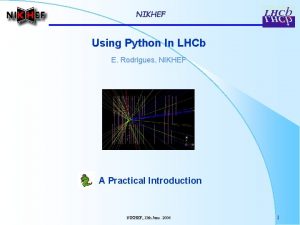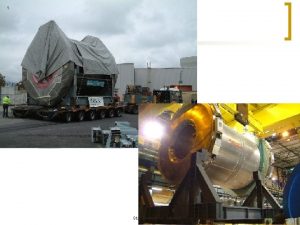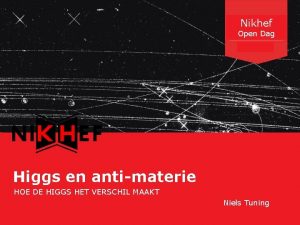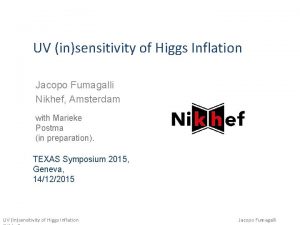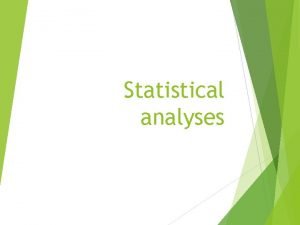Statistical aspects of Higgs analyses W Verkerke NIKHEF























- Slides: 23

Statistical aspects of Higgs analyses W. Verkerke (NIKHEF)

Introduction • Enormous effort to search for Higgs signature in many decay channels • Results many plots with signal, background expectations, each with (systematic) uncertainties, and data • Q: How do you conclude from this that you’ve seen the Higgs (or not)? – Want answer of type: ‘We can exclude that the Higgs exist at 95% CL”, or “Probability that background only caused observed excess is 3·10 -7 • Here a short guide through how this is (typically) done

Quantifying discovery and exclusion – Frequentist approach • Consider the simplest case – a counting experiment – Observable: N (the event count) – Model F(N|s): Poisson(N|s+b) with b=5 known exactly • Predicted distributions of N for various values of s s=0 s=5 s=10 s=15

Frequentist p-values – excess over expected bkg • Now make a measurement N=Nobs (example Nobs=7) • Can now define p-value(s), e. g. for bkg hypothesis – Fraction of future measurements with N=Nobs (or larger) if s=0 s=5 s=10 s=15

Frequentist p-values - excess over expected bkg • p-values of background hypothesis is used to quantify ‘discovery’ = excess of events over background expectation • Another example: Nobs=15 for same model, what is pb? s=0 s=5 s=10 s=15 – Result customarily re-expressed as odds of a Gaussian fluctuation with equal p-value (3. 5 sigma for above case) – NB: Nobs=22 gives pb < 2. 810 -7 (‘ 5 sigma’)

Upper limits (one-sided confidence intervals) • Can also defined p-values for hypothesis with signal: ps+b – Note convention: integration range in ps+b is flipped p(s=15) = 0. 00025 p(s=10) = 0. 007 p(s=5) = 0. 13 p(s=6. 8) = 0. 05 • Convention: express result as value of s for which p(s+b)=5% “s>6. 8 is excluded at 95% C. L. ” Wouter Verkerke, NIKHEF

Modified frequentist upper limits • Need to be careful about interpretation p(s+b) in terms of inference on signal only – Since p(s+b) quantifies consistency of signal plus background – Problem most apparent when observed data has downward stat. fluctations w. r. t background expectation • Example: Nobs =2 ps+b(s=0) = 0. 04 s=0 s≥ 0 excluded at >95% C. L. ? ! • Modified approach to protect against such inference on s – Instead of requiring p(s+b)=5%, require s=5 s=10 s=15 for N=2 exclude s>3. 4 at 95% C. L. s, for large N effect on limit is small as p b 0

p-values and limits on non-trivial analysis • Typical Higgs search result is not a simple number counting experiment, but looks like this: - Result is a distribution, not a single number - Models for signal and background have intrinsic uncertainties • Any type of result can be converted into a single number by constructing a ‘test statistic’ – A test statistic compresses all signal-to-background discrimination power in a single number – Most powerful discriminators are Likelihood Ratios (Neyman Pearson)

The likelihood ratio test statistic • Definition: μ = signal strength / signal strength(SM) – Choose e. g likelihood with nominal signal strength in numerator (μ=1) ‘likelihood assuming nominal signal strength’ ^ is best fit μ value of μ ‘likelihood of best fit’ • Illustration on model with no shape uncertainties On signal-like data q 1 is small On background-like data q 1 is large

Distributions of test statistics • Value of q 1 on data is now the ‘measurement’ • Distribution of q 1 not calculable But can obtain distribution from pseudo-experiments • Generate a large number of pseudo-experiments with a given value of mu, calculate q for each, plot distribution Note analogy to Poisson counting example q 1 for experiments with background only q 1 for experiments with signal • From qobs and these distributions, can then set limits similar to what was shown for Poisson counting example

Incorporating systematic uncertainties • What happens if models have uncertainties Jet Energy Scale, QCD scale, luminosity, . . . – Introduction of additional model parameters θ that describe effect of uncertainties θ 1 x θ 2 x

Incorporating systematic uncertainties Likelihood includes auxiliary measurement terms that constrains the nuisance parameters θ (shape is flat, log-normal, gamma, or Gaussian) θ 1 x θ 2 x

Dealing with nuisance parameters in the test statistic • Uncertainty quantified by nuisance parameters are incorporated in test statistic using a profile likelihood ratio ‘likelihood of best fit for a given fixed value of μ’ ‘likelihood of best fit’ (with a constraint ) • Interpretation of observed value of qμ in terms of p-value again based on expected distribution obtained from pseudo-experiments

Dealing with nuisance parameters in the test statistic • Uncertainty quantified by nuisance parameters are incorporated using a profile likelihood ratio test statistic μ=0. 35 μ=1. 0 μ=1. 8 μ=2. 6 ‘likelihood of best fit for a given fixed value of μ’ ‘likelihood of best fit’ (with a constraint ) • Interpretation of observed value of qμ in terms of p-value again based on expected distribution obtained from pseudo-experiments

Putting it all together for one Higgs channel • Result from data D(x) • PDF F(x|m. H, μ, θ) that models the data for a given true Higgs mass hypothesis • Construct test statistic • Obtain expected distributions of qμ for various μ – Determine ‘discovery’ p-value and signal exclusion limit • Repeat for each assumed m. H. . Wouter Verkerke, NIKHEF

Example – 95% Exclusion limit vs m. H for H WW Example point: ≈3 x SM H WW cross-section excluded at m. H=125 Ge. V Expected exclusion limit for background-only hypothesis Example point: ≈0. 5 x SM H WW cross-section excluded at m. H=165 Ge. V Higgs with 1. 0 x SM cross-section excluded at 95% CL for m H in range [150, ~187]

Combining Higgs channels (and experiments) • Procedure: define joint likelihood • Correlations between θWW, θγγ etc and between θATLAS, θCMS requires careful consideration! • The construction profile likelihood ratio test statistic from joint likelihood and proceed as usual Wouter Verkerke, NIKHEF

A word on the machinery • Common tools (Roo. Fit/Roo. Stats - all available in ROOT) have been developed in past 2/3 years to facilitate these combinations – Analytical description of likelihood of each component stored and delivered in a uniform language (‘Roo. Fit workspaces’) – Construction of joint likelihood technically straightforward ‘llll/110. root’ ‘gg/110. root’ Wouter Verkerke, NIKHEF

Example – joint ATLAS/CMS Higgs exclusion limit Wouter Verkerke, NIKHEF

Switching from ‘exclusion’ to ‘discovery’ formulation ‘exclusion’ ‘discovery’ ‘likelihood assuming μ signal strength’ ‘likelihood assuming background only’ ‘likelihood of best fit’ simulated data with signal+bkg simulated data with bkg only Wouter Verkerke, NIKHEF

Comb: p-value of background-only hypothesis (‘discovery’) Expected p-value for background hypothesis of a data sample containing SM Higgs boson Note that ‘peak’ around 160 Ge. V reflects increased experimental sensitivity not SM prediction of Higgs mass

Comb: p-value of background-only hypothesis (‘discovery’) Example point: at m. H≈150 Ge. V probability to obtain observed event count (or larger) here from background only is ~0. 0015% (~3σ) But need to be careful with local p-values Search is executed for a wide m. H mass range. Odds to find a local p-value of e. g. 1% anywhere in mass range (the ‘global p-value’) is larger than 1% Can a estimate trial factor (global p/local p) and obtain estimate of global significance by using trial factor as correction

Conclusions • We are early awaiting more data! Wouter Verkerke, NIKHEF
 Servicdesk
Servicdesk Eric laenen
Eric laenen Nikhef
Nikhef Wouter verkerke
Wouter verkerke Wouter verkerke
Wouter verkerke Langrangian
Langrangian Critical thinking in nursing process
Critical thinking in nursing process Wwh set
Wwh set Geicp
Geicp Concln
Concln Higgs singlet
Higgs singlet Higgs
Higgs Higgs singlet
Higgs singlet Bosone di higgs
Bosone di higgs Scence
Scence Hungry higgs
Hungry higgs Higgs boson
Higgs boson Two higgs doublet model
Two higgs doublet model Higgs factory
Higgs factory Higgs boson
Higgs boson Higgs
Higgs Higgs boson black hole
Higgs boson black hole Higgs factory
Higgs factory Higgs to tau tau
Higgs to tau tau

